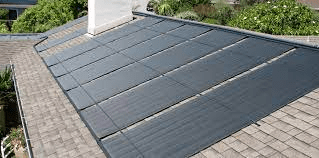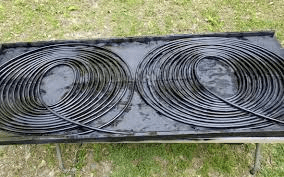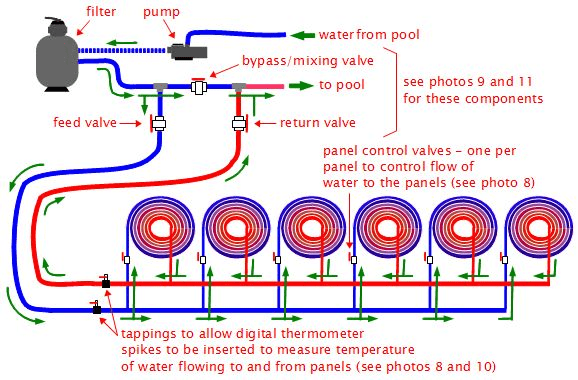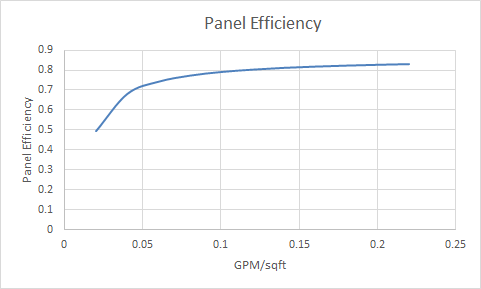| Line 30: | Line 30: | ||
*[https://www.suntreksolar.com/solar-pool-systems/why-choose-suntrek/ Suntrek] sells EPDM panels. They run horizontal instead of vertical and conform to the roof much better (especially tile) than ridged panels. However, they have one downside: [https://poolsolarwa.com/why-pvc-is-better-than-epdm-for-solar-pool-heating-systems/Why PVC Is Better than EPDM for Solar Pool Heating Systems] <ref>https://www.troublefreepool.com/threads/solar-panels.177925/post-1572387</ref> | *[https://www.suntreksolar.com/solar-pool-systems/why-choose-suntrek/ Suntrek] sells EPDM panels. They run horizontal instead of vertical and conform to the roof much better (especially tile) than ridged panels. However, they have one downside: [https://poolsolarwa.com/why-pvc-is-better-than-epdm-for-solar-pool-heating-systems/Why PVC Is Better than EPDM for Solar Pool Heating Systems] <ref>https://www.troublefreepool.com/threads/solar-panels.177925/post-1572387</ref> | ||
*H2otSun does have some flexible alternates that can be installed like SunTrek's and don't have the same problem as EPDM. [https://www.h2otsun.com/tile H2otSun Powerstrip solar panels] are made for tile roofs. | *H2otSun does have some flexible alternates that can be installed like SunTrek's and don't have the same problem as EPDM. [https://www.h2otsun.com/tile H2otSun Powerstrip solar panels] are made for tile roofs. | ||
| + | *[https://techno-solisusa.com/ TechnoSolis] | ||
*Heliocoil | *Heliocoil | ||
Revision as of 21:12, 5 April 2022
Solar Pool Heaters
The Department of Energy (DOE) has a webpage describing Solar Swimming Pool Heaters. They say:
You can significantly reduce swimming pool heating costs by installing a solar pool heater. They're cost competitive with both gas and heat pump pool heaters, and they have very low annual operating costs. Actually, solar pool heating is one of the most cost-effective use of solar energy in some climates.
Bubble covers can make a huge difference in what you get out of a solar heater.
Solar Controllers
For maximum efficiency of a pool solar heating system a solar valve controller should be used. The controller has a solar temperature sensor, typically installed near the panels, and an actuator controlled valve. When the solar temperature sensor tells the controller the heat at the panels is greater then the pool water the valve is opened to flow water through the panels to capture the heat. When the solar controller senses there is not sufficient solar heat to heat the water the water flow through the panels is stopped.
The solar controller has to sense at least a 4 degree difference between the temperature at the panels and the pool water to flow water through the solar panels.
Without a Solar Controller the solar panels will heat the water when the sun is out but can cool the water when clouds pass over. The Solar controller can turn water flow to the panels on and off many times during the day as clouds pass over to heat the water and not let it be cooled.
Pentair, Hayward and others have Solar Controllers and solar control is integrated into many automation systems.
Sizing a Solar Pool Heating System
When a professional comes to give you a solar pool heating estimate the minimum square feet is 50% of pool area, ideal is 75-100%.[1]
On average only 1/3 of the circumference of the solar piping is available for capturing the sun's energy. This is because you have to take the angle of the sun's incidence on to the surface of the pipe into account and when you do that, you find that the capture area is proportional to the pipe diameter and not it's circumference. Basically, the energy captured by a solar panel is proportional to the area of the shadow it casts.[2]
Selecting Solar Panels
There are many different designs in solar panels to select from. Where you will mount them - roof or ground, type of roof you have, and the your weather environment are all considerations.
- Falco panels have individual tubes, so the wind can flow thru them, instead of lifting up.
- Suntrek sells EPDM panels. They run horizontal instead of vertical and conform to the roof much better (especially tile) than ridged panels. However, they have one downside: PVC Is Better than EPDM for Solar Pool Heating Systems [3]
- H2otSun does have some flexible alternates that can be installed like SunTrek's and don't have the same problem as EPDM. H2otSun Powerstrip solar panels are made for tile roofs.
- TechnoSolis
- Heliocoil
DIY Solar Pool Heaters
Solar pool heaters and hot water solar heaters are too different designs. One is used to heat a lot of water just a little bit while the other is used to heat a little water a lot. Using a hot water design for a pool will results in less than satisfactory results. What you want is a lot of surface area with many very small tubes all in parallel for high flow rates and high efficiency. Something like a commercial pool solar panel:[4]
Diyers generally use landscape tubing in coils much like this:
But if you go this route, it is best to use several coils in parallel to keep the tube length short and flow rates higher. One of the biggest mistakes DIYers make is to use one very long tube coiled up. That creates a lot of head loss limiting the amount of flow through the panel. Higher flow rates through the tubing results in better efficiency. This is what you want (although the pump is shown backwards and solar valves should be used):
For a 400 sq-ft pool, you will want at least 200 sq-ft of panels. Using 1/2" tubing (0.7" O.D.), that is about 3500' of tubing.
Optimum Flow Rate for Solar Panels
You don't want much temperature difference between the inlet and out of solar panels. Less than 5F rise is normal operation. Also, the temperature difference is proportional to the flow rate through the panels.[5]
Consult the panel manufacturer's documentation and then do the math. For example 40GPM is needed if you have 8 panels and the manufacture specifies 5GPM each.
Most manufactures recommend 0.1 GPM/sq-ft. or about 5 GPM for a 4x12 panel. 30 GPM for 6 panels and 40 GPM for 8 panels. Lower than that and efficiency starts to drop off. Higher than that and efficiency doesn't improve much.
Here is a typical efficiency curve:
Then install a FlowVis flow meter in the pool plumbing (about $150). Then it is a very simple matter of adjusting your VS pump to get the flow meter to read 40GPM. You should check the flow rate a few times a season, as filter resistance can change over time (as the filter gets dirty). You can then just tweak the VS pump speed to accommodate.[6]
There are many variables (pool size, number and type of panels, height of panels, pipe size, number of elbows, etc, etc), there is no way an automation system can figure all that out. Nor can a pool guy or solar panel manufacturer (or forum member) tell you a generic RPM number that would work best for your particular system. Each system will have its own best setting.
Solar Panel Exposure
With everything being equal (i.e. shading, tilt, etc), western exposures are usually always better than eastern exposures. This is because air temperatures in the afternoon are higher than in the morning which increases convective heat gain (or lower heat loss).[7]
For heat gain from the sun, it is all about angle of incidence to the panels (normal incidence is better). If solar noon is at 1 pm, 12 pm or 2 pm is going to have exactly the same heat gain assuming the panels are pointed directly to solar noon.[8]
Normal incidence is a 90 degree angle from the surface of the panels to the sun so the sun rays are orthogonal to the panel surface. When the angle of incidence is off normal, there is less projected capture area of the panels to the sun by the cosine of the angle off normal and there is less heat gain.[9]
For example, if the elevation of the sun is 15 degrees off zenith (75 degree elevation) and the roof has a 15 degree pitch and the panels are pointed at solar noon, the panels are capturing all the sun they can at that point in time. However, on the north side of the roof, there will be 30 degree angle of incidence so the loss in heat gain is about 14% lower than the south side of the roof. So if you want heat gain to be the same, you need more panels. The steeper the roof, the more pronounced the effect. As the sun moves across the sky, the effect is even more pronounced. North facing panels work, just not as well.
However, the first component of heat loss is dependent on air temperature and air temperature tends to rise and peak after solar noon. So between morning and afternoon, there will be more net heat gain in the afternoon.
The second heat loss component is radiation heat loss, the largest component. If you can shield the panels to the general sky, but not the sun, you can reduce heat loss significantly. Trees work great for radiation heat shielding. You just don't want them shielding the sun.
Heat is gained from the sun in the direction of the sun only. However, radiation losses occur in all directions and are proportional to the fourth power of the absolute temperature difference between the panel and sky. The sky temperature is typically 20-30 degrees below the air temperature so a lot of heat can be loss between the panels and the sky. If there is an object (buildings, trees, etc) between the panels and any portion of the sky, this heat loss is reduced because the objects tend to be at a higher temperature.
Also, wind breaks such as trees and fences can help because this reduces the wind across the panels.
The third component is conduction. Elevating the panels above ground can reduce that.
- ↑ https://www.troublefreepool.com/threads/solar-heat-reduce-pump-output-from-1-5-to-1.180773/post-1598663
- ↑ https://www.troublefreepool.com/threads/solar-heat-reduce-pump-output-from-1-5-to-1.180773/post-1599315
- ↑ https://www.troublefreepool.com/threads/solar-panels.177925/post-1572387
- ↑ https://www.troublefreepool.com/threads/diy-solar-heating.248780/post-2179574
- ↑ https://www.troublefreepool.com/threads/new-solar-heater.212864/post-1864320
- ↑ https://www.troublefreepool.com/threads/pump-speed-for-solar-heating.246514/post-2159465
- ↑ https://www.troublefreepool.com/threads/pool-solar-new-roof-should-i-go-east-or-west.247862/post-2171260
- ↑ https://www.troublefreepool.com/threads/whats-the-cheapest-way-i-can-mount-5-4x10-solar-panels-to-my-roof.172596/post-1523559
- ↑ https://www.troublefreepool.com/account/alerts





